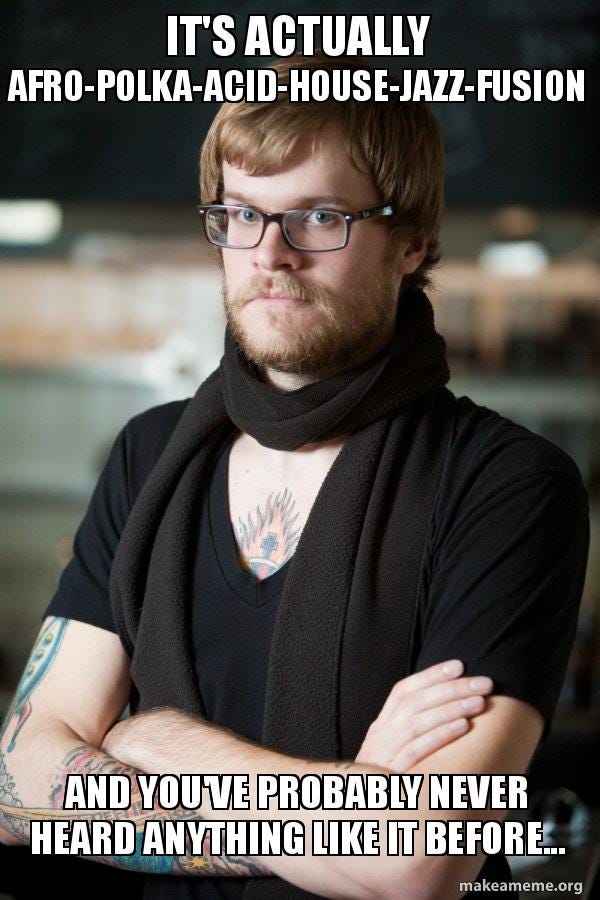Carefully curated creative
Balancing the populist and the obscure when we present creative ideas
One of my top ten favourite books is "Kill Your Friends" by John Niven. It's the story of a cutthroat record label exec set in the post-Britpop late nineties. It's a brutally honest portrayal of the music industry and includes a memorable passage on how bands performatively curate their influences. "Oh yeah, we're influenced by everyone from The Velvet Underground to Miles Davis by way of the Spice Girls". That kind of thing. The list of artists has been pored over for hours, all to present an image of a band that blends just the right amount of populism with just the right amount of hipster coolness.
As I think about where inspiration comes from for our campaigns and creative ideas, I feel we strive for similar balance, with not a little bit of that same performance.
"All ideas are second-hand, consciously and unconsciously drawn from a million outside sources." So says Mark Twain in a letter to Helen Keller (sourced from the excellent Marginalian newsletter, which I encourage you all to read). Even if you don't use the inspiration for your idea in how you explain it to someone, that idea came from somewhere. It might take a bit of time, but you can unpack the history of any idea, even if it came to you in the shower with a flash of divine inspiration.
Tracing the history of an idea, and revealing some of its sources, is often the key to selling great creative. I can't tell you how many times I've started a BIG IDEA reveal slide with a phrase like: "what if we took the basic idea of Ready, Steady, Cook and applied it to the cutting edge field of cell and gene therapy? We'll create a brand new social-first video series that challenges our scientists to develop new ideas from a fixed set of resources in a tight timeframe". (You can have that idea for free if you're working on a pharma brief).
Selling great ideas is about bringing your audience along on a journey, telling them a simple story that creates momentum and excitement for the concept itself. You want people to nod and say yes, I get this. Key to that is the cultural reference points and sources that are popular enough to be recognised by your audience but not so ubiquitous as to be completely overdone. Like many bands from the 90s and 00s, you're creating your wired/tired lists. Continually searching for that sweet spot of a trend that is not so obscure that it takes too long to explain but has yet to be jumped on by a million other brands.
It requires creativity within the stories we tell ourselves. When searching for creative inspiration, you may have been stuck for time and gone straight to your most reliable source. For me, that's the excellent Hello You Creatives, a trawl of YouTube stand-up routines on my chosen topic, or that timeless classic - award-winning campaigns on Contagious. The challenge is that you might want to avoid referencing such an obvious inspiration in your pitch response. It's the equivalent of a band saying they're influenced by The Beatles. They probably are, but it's way too obvious to share with the world.
You might look for different routes for your inspiration - a long read from The Guardian or The New Yorker (I built a custom GPT to find such long reads). A YouTube video series. Or tie it into something from a trend report. I know we're out of prediction season now, so it's not cool to share those, but Matt Klein's meta-trends analysis is worth a look in the spirit of breaking the rules every now and again. It's got plenty of great made-up phrases you can use to curate your influences and go from The Beatles (tired) to indie sleaze (wired).
My faves from that meta trends list include Doomerism (permacrisis collapse triggers sobering nihilism and overwhelming anxiety) and Nostalgia Spins (the eternal spin cycle of nostalgia throws up Y2K… and any time but now).
The art of curation is increasingly crucial in a world where trends burn brighter but more briefly than ever. It's important to know which trends have just the right amount of cultural resonance to support a great idea and which are already out of date by the time of your pitch. It can create a tightrope if your presentation or deadline ends up being put back - you might have a great idea that taps into the current nostalgia spin on indie sleaze, but who knows how long that will be.
As ever with trends and influences, the trick is to separate the longer-term trends from their short-term, micro counterparts. The one-hit wonders from the multi-album stars. You're more likely to be on safer ground and more likely to find something that the majority of your audience understands without explanation. Whereas two years ago, it was all about the 90s trends, now noughties nostalgia is back in vogue. The music (indie sleaze again), the TV shows and wider culture of 2000s is all the rage on TikTok - according to The Guardian at least. But you’ve got to wonder if dresses over jeans will also make a comeback. The joy of curating your nostalgia spins is that you can ignore those bits of the past you'd like to conveniently forget - I certainly won't be bringing back the blonde stripe I had through my hair (Kevin Pietersen-style) in the mid-00s. My haircuts tend to stay firmly on the "tired" list, never to be seen again.




